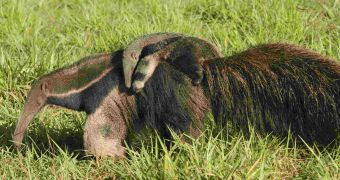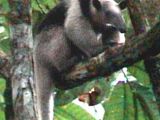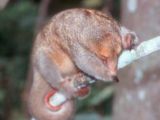There are 4 species of anteaters living in the tropical parts of Americas. Silky anteater has just 45 cm (1.5 ft) in length and weigh one pound (0.4 kg), while the giant anteater up to 2.4 m (8 ft) in total length, weighing up to 30 kg (66 pounds).
Anteaters are solitary, territorial and nocturnal; 3 species are arboreal (two tamandua and the silky anteater) and only the giant anteater is a ground dweller. This one is active both during the day and the night. These mammals mark their territory leaving scent marks on trees or paths with a liquid produced by their anal glands. The scent is extremely powerful in the case of the tamandua, famous for this.
Usually anteaters rely on camouflage for hiding from predators, but if necessary they can defend with their strong claws. These mammals, along with baleen whales and monotremes (platypus and echidna) are the only ones completely toothless. Their lack of teeth (for chewing food) is compensated by the extremely muscular stomach (which grinds tough bodied ants).
Anteaters have a good smell, a weak hearing and an even weaker sight: they seem to see just shadows of black and white.
Anteaters have prolonged body and face, and conic muzzle. The giant anteater has coarse coat and a bushy tail. The other three species have prehensile (grasping) Tails, an adaptation to life in the trees. Tamandua anteaters have large, conspicuous ears, which could indicate good hearing.
The tree anteaters live in tropical forests, while the giant anteater lives in savannas, grasslands, swamps, and forests.
On the ground, anteaters step the side of the fingers or the wrist for protecting their long claws. The giant anteaters can even gallop. Tree anteaters sleep in tree hollows and move clumsy and slowly on the ground.
Anteaters eat just ants and termites, whose colonies are found with the help of the smell. The strong claws are used to break the mounds' walls. The giant anteater can consume up to 30,000 ants daily, but generally it feeds only one minute at a nest, consuming about 150 ants at once, after which it looks for another nest. As the animal knows all the ant nests on its territory, it never destroys them.
Tamandua feed especially on tree termites, while the silky anteater prefers the tree ants. Anteaters can consume also other insects, like bees, beetle larvae and honey.
Prey is collected with their long and slender tongue, which can be put out of the mouth 60 cm (2 ft) in the case of the giant anteater! The tongue is wrapped in a sticky saliva, gathering the insects which are brought inside the mouth.
Females give birth once a year to a well developed offspring while standing on its feet. The offspring climbs to its mother's back, when it remains riding and it is cleaned by the mother with her long tongue. The young are fed with milk for 6 months. Tamandua can give birth sometimes to twins.
The offspring is (are) transported on the mother's back for about one year. In the case of the silky anteaters, both parents take care of the young, feeding it with regurgitated semidigested food.

 14 DAY TRIAL //
14 DAY TRIAL // 

